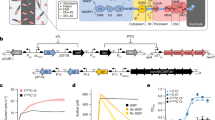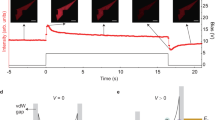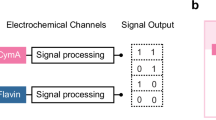Abstract
Quantum confinement in monolayer semiconductors results in optical properties intricately linked to electrons, which can be manipulated by external electric fields. These optoelectronic features offer untapped potential for studying biological electrical activity. In addition to their relatively high quantum yields, picosecond level emission lifetimes make these materials particularly promising for monitoring biological voltages with high spatiotemporal resolution. Here we investigate exciton-to-trion conversion in ångström-thick semiconductors to experimentally demonstrate label-free, dual-polarity, all-optical detection of electrical activity, via changes in photoluminescence, in cardiomyocyte cultures with ultrahigh temporal resolution. We devise a physical model to demonstrate that this conversion process is inherently governed by the quantum statistics of the background electrons induced by biological activity. We show that the monolayer MoS2 enables completely bias-free tetherless operation due to its substantial trion density originating from intrinsic sulfur vacancies introduced during chemical vapour deposition. Our work opens up an unexplored avenue of opportunities for label-free all-optical voltage sensing using ångström-thick semiconductor materials whose applications have been elusive in the biological domain. This line of thinking at the intersection of biology and quantum science could lead to the discovery of non-ubiquitous quantum materials for detection of biological electrical activity.
This is a preview of subscription content, access via your institution
Access options
Access Nature and 54 other Nature Portfolio journals
Get Nature+, our best-value online-access subscription
$32.99 / 30 days
cancel any time
Subscribe to this journal
Receive 12 print issues and online access
$259.00 per year
only $21.58 per issue
Buy this article
- Purchase on SpringerLink
- Instant access to full article PDF
Prices may be subject to local taxes which are calculated during checkout




Similar content being viewed by others
Data availability
All data are available in the Article and its Supplementary Information and via Zenodo at https://doi.org/10.5281/zenodo.14641718 (ref. 59).
Code availability
The code used to generate the figures for this work is available via Zenodo at https://doi.org/10.5281/zenodo.14641718 (ref. 59).
References
Mak, K. F., Lee, C., Hone, J., Shan, J. & Heinz, T. F. Atomically thin MoS2: a new direct-gap semiconductor. Phys. Rev. Lett. 105, 136805 (2010).
Zhang, X. et al. Guiding of visible photons at the ångström thickness limit. Nat. Nanotechnol. 14, 844–850 (2019).
Reed, J. C., Zhu, A. Y., Zhu, H., Yi, F. & Cubukcu, E. Wavelength tunable microdisk cavity light source with a chemically enhanced MoS2 emitter. Nano Lett. 15, 1967–1971 (2015).
Liu, W. et al. Generation of helical topological exciton-polaritons. Science 370, 600–604 (2020).
Hus, S. M. et al. Observation of single-defect memristor in an MoS2 atomic sheet. Nat. Nanotechnol. 16, 58–62 (2021).
Wu, F. et al. Vertical MoS2 transistors with sub-1-nm gate lengths. Nature 603, 259–264 (2022).
Mak, K. F. & Shan, J. Photonics and optoelectronics of 2D semiconductor transition metal dichalcogenides. Nat. Photonics 10, 216–226 (2016).
Wang, M. et al. Plasmon–trion and plasmon–exciton resonance energy transfer from a single plasmonic nanoparticle to monolayer MoS2. Nanoscale 9, 13947–13955 (2017).
Sie, E. J., Frenzel, A. J., Lee, Y.-H., Kong, J. & Gedik, N. Intervalley biexcitons and many-body effects in monolayer MoS2. Phys. Rev. B 92, 125417 (2015).
Yu, Y. et al. Fundamental limits of exciton-exciton annihilation for light emission in transition metal dichalcogenide monolayers. Phys. Rev. B 93, 201111 (2016).
Sie, E. J. et al. Observation of exciton redshift–blueshift crossover in monolayer WS2. Nano Lett. 17, 4210–4216 (2017).
Wiesner, M. et al. Signatures of bright-to-dark exciton conversion in corrugated MoS2 monolayers. Appl. Surf. Sci. 600, 154078 (2022).
Zhang, X. et al. Unidirectional doubly enhanced MoS2 emission via photonic Fano resonances. Nano Lett. 17, 6715–6720 (2017).
Ross, J. S. et al. Electrical control of neutral and charged excitons in a monolayer semiconductor. Nat. Commun. 4, 1474 (2013).
Zhang, X. et al. Dynamic photochemical and optoelectronic control of photonic fano resonances via monolayer MoS2 trions. Nano Lett. 18, 957–963 (2018).
Lee, B. et al. Electrical tuning of exciton–plasmon polariton coupling in monolayer MoS2 integrated with plasmonic nanoantenna lattice. Nano Lett. 17, 4541–4547 (2017).
Lien, D.-H. et al. Electrical suppression of all nonradiative recombination pathways in monolayer semiconductors. Science 364, 468–471 (2019).
Yang, H. H. & St-Pierre, F. Genetically encoded voltage indicators: opportunities and challenges. J. Neurosci. 36, 9977–9989 (2016).
Knöpfel, T. & Song, C. Optical voltage imaging in neurons: moving from technology development to practical tool. Nat. Rev. Neurosci. 20, 719–727 (2019).
He, B., Yang, L., Wilke, C. & Yuan, H. Electrophysiological imaging of brain activity and connectivity—challenges and opportunities. IEEE Trans. Biomed. Eng. 58, 1918–1931 (2011).
Vaquero, D. et al. Excitons, trions and Rydberg states in monolayer MoS2 revealed by low-temperature photocurrent spectroscopy. Commun. Phys. 3, 194 (2020).
Pei, J. et al. Exciton and trion dynamics in bilayer MoS2. Small 11, 6384–6390 (2015).
Klein, J. et al. Controlling exciton many-body states by the electric-field effect in monolayer MoS2. Phys. Rev. Res. 3, L02200 (2021).
Mak, K. F. et al. Tightly bound trions in monolayer MoS2. Nat. Mater. 12, 207–211 (2013).
Lui, C. et al. Trion-induced negative photoconductivity in monolayer MoS2. Phys. Rev. Lett. 113, 166801 (2014).
Xie, C., Lin, Z., Hanson, L., Cui, Y. & Cui, B. Intracellular recording of action potentials by nanopillar electroporation. Nat. Nanotechnol. 7, 185–190 (2012).
Liu, R. et al. High density individually addressable nanowire arrays record intracellular activity from primary rodent and human stem cell derived neurons. Nano Lett. 17, 2757–2764 (2017).
Spira, M. E., Shmoel, N., Huang, S.-H. M. & Erez, H. Multisite attenuated intracellular recordings by extracellular multielectrode arrays, a perspective. Front. Neurosci. 12, 212 (2018).
Müller, J. et al. High-resolution CMOS MEA platform to study neurons at subcellular, cellular, and network levels. Lab Chip 15, 2767–2780 (2015).
Rocha, P. R. F. et al. Electrochemical noise and impedance of Au electrode/electrolyte interfaces enabling extracellular detection of glioma cell populations. Sci. Rep. 6, 34843 (2016).
Viswam, V., Obien, M. E. J., Franke, F., Frey, U. & Hierlemann, A. Optimal electrode size for multi-scale extracellular-potential recording from neuronal assemblies. Front. Neurosci. 13, 385 (2019).
Abbott, J. et al. A nanoelectrode array for obtaining intracellular recordings from thousands of connected neurons. Nat. Biomed. Eng. 4, 232–241 (2019).
Wang, H., Zhang, C. & Rana, F. Surface recombination limited lifetimes of photoexcited carriers in few-layer transition metal dichalcogenide MoS2. Nano Lett. 15, 8204–8210 (2015).
Shah, P., Narayanan, T. N., Li, C.-Z. & Alwarappan, S. Probing the biocompatibility of MoS2 nanosheets by cytotoxicity assay and electrical impedance spectroscopy. Nanotechnology 26, 315102 (2015).
Wang, S. et al. Biocompatible PEGylated MoS2 nanosheets: controllable bottom-up synthesis and highly efficient photothermal regression of tumor. Biomaterials 39, 206–217 (2015).
Scanziani, M. & Häusser, M. Electrophysiology in the age of light. Nature 461, 930–939 (2009).
Amani, M. et al. Near-unity photoluminescence quantum yield in MoS2. Science 350, 1065–1068 (2015).
Li, Z. et al. Mechanistic insight into the chemical treatments of monolayer transition metal disulfides for photoluminescence enhancement. Nat. Commun. 12, 6044 (2021).
Butun, S., Tongay, S. & Aydin, K. Enhanced light emission from large-area monolayer MoS2 using plasmonic nanodisc arrays. Nano Lett. 15, 2700–2704 (2015).
Palacios, E., Park, S., Butun, S., Lauhon, L. & Aydin, K. Enhanced radiative emission from monolayer MoS2 films using a single plasmonic dimer nanoantenna. Appl. Phys. Lett. 111, 031101 (2017).
Pelton, M., Sheldon, M. & Khurgin, J. Plasmon-exciton coupling. Nanophotonics 8, 513–516 (2019).
Wong, R. K., Prince, D. A. & Basbaum, A. I. Intradendritic recordings from hippocampal neurons. Proc. Natl Acad. Sci. USA 76, 986–990 (1979).
Stuart, G. J. & Sakmann, B. Active propagation of somatic action potentials into neocortical pyramidal cell dendrites. Nature 367, 69–72 (1994).
Dipalo, M. et al. Intracellular and extracellular recording of spontaneous action potentials in mammalian neurons and cardiac cells with 3D plasmonic nanoelectrodes. Nano Lett. 17, 3932–3939 (2017).
Kannan, M., Vasan, G. & Pieribone, V. A. Optimizing strategies for developing genetically encoded voltage indicators. Front. Cell. Neurosci. 13, 53 (2019).
Zhang, Y. et al. Fast and sensitive GCaMP calcium indicators for imaging neural populations. Nature 615, 884–891 (2023).
St-Pierre, F. et al. High-fidelity optical reporting of neuronal electrical activity with an ultrafast fluorescent voltage sensor. Nat. Neurosci. 17, 884–889 (2014).
Akemann, W., Lundby, A., Mutoh, H. & Knöpfel, T. Effect of voltage sensitive fluorescent proteins on neuronal excitability. Biophys. J. 96, 3959–3976 (2009).
Efros, A. L. et al. Evaluating the potential of using quantum dots for monitoring electrical signals in neurons. Nat. Nanotechnol. 13, 278–288 (2018).
Parzinger, E. et al. Photocatalytic stability of single-and few-layer MoS2. ACS Nano 9, 11302–11309 (2015).
Rhee, J. K. et al. Biophysical parameters of GEVIs: considerations for imaging voltage. Biophys. J. 119, 1–8 (2020).
Zhou, Y. et al. Dual-color optical recording of bioelectric potentials by polymer electrochromism. J. Am. Chem. Soc. 144, 23505–23515 (2022).
Zhou, Y., Liu, E., Muller, H. & Cui, B. Optical electrophysiology: toward the goal of label-free voltage imaging. J. Am. Chem. Soc. 143, 10482–10499 (2021).
Alfonso, F. S. et al. Label-free optical detection of bioelectric potentials using electrochromic thin films. Proc. Natl Acad. Sci. USA 117, 17260–17268 (2020).
Habib, A. et al. Electro-plasmonic nanoantenna: a nonfluorescent optical probe for ultrasensitive label-free detection of electrophysiological signals. Sci. Adv. 5, eaav9786 (2019).
Hardy, N., Habib, A., Ivanov, T. & Yanik, A. A. Neuro-SWARM³: system-on-a-nanoparticle for wireless recording of brain activity. IEEE Photonics Technol. Lett. 33, 900–903 (2021).
Barry, J. F. et al. Optical magnetic detection of single-neuron action potentials using quantum defects in diamond. Proc. Natl Acad. Sci. USA 113, 14133–14138 (2016).
McCloskey, D. et al. A diamond voltage imaging microscope. Nat. Photonics 16, 730–736 (2022).
Yundong, R. et al. Source data and code for ‘Trionic all-optical biological voltage sensing via quantum statistics’. Zenodo https://doi.org/10.5281/zenodo.14641718 (2025).
Acknowledgements
We acknowledge funding from the National Science Foundation (NSF; grants ECCS-2139416 to E.C.; ECCS-2024776, ECCS-1752241 and ECCS-1734940 to D.K), National Institutes of Health (NIH; grants 1R21EY033676 to E.C.; 21EY029466, R21EB026180 and DP2 EB030992 to D.K.; and R01AG045428 to A.J.E.), Office of Naval Research (ONR; grants N000142012405, N000142312163 and N000141912545 to D.K.), G.G. acknowledges fellowships from the NSF GRFP, NIH (grant T32HL007444), the San Diego fellowship and the Seibel Scholars programme for financial support. Fabrication of the devices was performed at the San Diego Nanotechnology Infrastructure of UCSD, a member of the National Nanotechnology Coordinated Infrastructure, which is supported by the NSF (grant ECCS-1542148).
Author information
Authors and Affiliations
Contributions
E.C. and D.K. conceived the project. E.C. developed the theory. Y.R., C.D., F.S., J.H.S. and E.C. performed optical characterization. Y.R., C.D. and F.S. fabricated devices. W.H. performed the FEM simulations. Y.R., F.S., M.N.W., M.R. and D.K. performed electrical characterization. G.G. and A.J.E. cultured cells. Y.R., M.R., D.K. and E.C. analysed the experimental data. Y.R., D.K., E.C. and A.J.E. wrote the paper.
Corresponding author
Ethics declarations
Competing interests
The authors declare no competing interests.
Peer review
Peer review information
Nature Photonics thanks Fedor Jelezko, Daniel McCloskey, Milos Nesladek and the other, anonymous, reviewer(s) for their contribution to the peer review of this work.
Additional information
Publisher’s note Springer Nature remains neutral with regard to jurisdictional claims in published maps and institutional affiliations.
Supplementary information
Supplementary Information
Supplementary Figs. 1–23 and discussion.
Supplementary Video 1
Fluorescence wide-field microscope recording showing the MoS2’s PL being modulated by a 20 Hz square wave varying from 0 to −60 mV. The field of view is around 200 μm × 200 μm. The video was recorded at 60 frames per second and is played back six times slower. Such wide-field imaging capability demonstrated the MoS2 voltage imaging sensor’s potential of capturing electrophysiology signals at a high spatiotemporal resolution without compromising field of view.
Supplementary Video 2
Fluorescence wide-field microscope recording showing the MoS2’s PL being modulated by a 200 Hz square wave varying from −25 to 25 mV. The reduced field of view of 30 μm × 30 μm allowed the MoS2 PL image to be captured at a frame rate of 500 frames per second. The video is played back 50× slower than the actual recording frame rate.
Supplementary Video 3
The video was recorded at 30 frames per second. The arrows overlay on the video indicated the direction and amplitude of the cell displacement.
Supplementary Video 4
Fluorescence wide-field microscope video of the MoS2 PL recorded at 50 frames per second and played back at 100 frames per second.
Supplementary Video 5
Fluorescence wide-field microscope video of the MoS2 PL recorded at 100 frames per second and played back at 50 frames per second. The two bright spots are the locations of the porated cells. The MoS2 PL has become brighter after exposure to the high intensity laser used to porate the cells. The blinking of the PL at these two spots are due to the intracellular action potential of the cardiomyocytes.
Rights and permissions
Springer Nature or its licensor (e.g. a society or other partner) holds exclusive rights to this article under a publishing agreement with the author(s) or other rightsholder(s); author self-archiving of the accepted manuscript version of this article is solely governed by the terms of such publishing agreement and applicable law.
About this article
Cite this article
Ren, Y., De-Eknamkul, C., Sun, F. et al. Trionic all-optical biological voltage sensing via quantum statistics. Nat. Photon. 19, 540–548 (2025). https://doi.org/10.1038/s41566-025-01637-w
Received:
Accepted:
Published:
Issue date:
DOI: https://doi.org/10.1038/s41566-025-01637-w
This article is cited by
-
Seeing quick beats with atomically thick sheets
Nature Photonics (2025)



